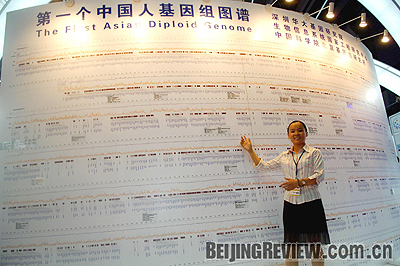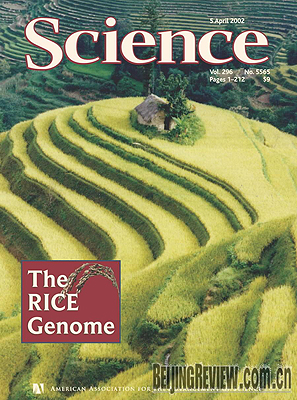|
|

HUMAN MAP: Scientists successfully completed the first sequence map of the diploid genome of an Asian individual in October 2007. The sequence was worked out by a group of scientists in Shenzhen and was on display at the Ninth Annual China Hi-tech Fair in the city last October |
After a year of analysis and strict evaluation, the world's first genome atlas of the Asian race made by Chinese scientists made the cover story of the latest edition of the prestigious science journal Nature.
Actually the genome atlas was completed in October 2007, by a team of scientists from the Shenzhen Huada Gene Institute, the National Engineering Research Center of Systematic Bioinformatics and the Beijing Gene Institute of the Chinese Academy of Sciences (CAS). This team includes the principal participants in the project to sequence 1 percent of the human genome.
|

GREAT ACHIEVEMENT: The cover story of the April 4 issue of Science magazine in 2002 was a 14-page report on rice genome mapping by 12 Chinese research centers | In classical genetics, the genome of a diploid organism refers to a full set of chromosomes, or genes, in a gamete. As for human beings, their genes determine their features and all kinds of diseases. There is a caryon in each cell of a human being, and in each caryon there are 23 pairs of chromosomes, each of which is an organized structure of DNA and protein.
According to scientists, the 23 pairs of chromosomes contain tens of thousands of genes, which form the genome. It is a code of life written in chemical materials. Therefore, to fully understand the secrets of life and heredity, DNA needs to be decoded.
In 1953, there was a breakthrough in discovering the life code when the DNA double helix was found. People began to understand DNA is stabilized by hydrogen bonds between the bases attached to its two strands. The four bases found in DNA are adenine (abbreviated A), cytosine (C), guanine (G) and thymine (T). The pairing of the four bases determines the uniqueness and continuity of life features.
Heredity ensures the continuity of life, while mutation leads to different types of species and the differences among human beings. "Different races of human beings have their unique heredity backgrounds, thus their bodies act differently to diseases," said Wang Jun, Associate Dean of Shenzhen Huada Gene Institute. He pointed out that mapping out the genome of the yellow race is of great importance as "Chinese people have their own genetic map."
Wang gave the example that Chinese people find the Asian flu virus easy to deal with, but for Europeans it is considered more serious. "People also want to know why Asians are more subject to certain diseases while European people aren't," Wang said.
"The biggest benefit of our gene research is to serve our health," said Wang. Scientists are drawing up 99 complete individual genome maps offering references to future health and medical treatment. They hope to cure inherited diseases by getting disordered genes back to normal according to a patient's genome atlas.
| 